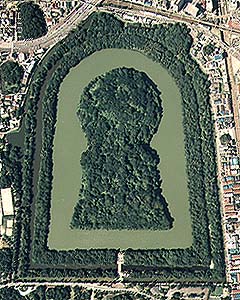Ryobo (Mausolea and Tombs)
| Photo | Description |
|---|---|
 mausoleum of Emperor Nintoku
(Photo:Sakai city, Osaka) |
Centred around the Kinki region of Japan, but stretching from Yamagata Prefecture in the north to Kagoshima Prefecture in the south, covering thirty-three prefectures are a total of 899 Imperial mausolea and tombs, including 188 burial mounds for senior members of the Imperial Family, 555 tombs of other members of the Imperial Family, 42 tombs that house the remains of human bone and ashes of Emperors and members of Imperial Family, 68 repositories for hair, teeth and nails, etc., and 46 sites that could possibly be mausolea. These mausolea and tombs are scattered over 460 areas, as some are located in the same region or area. The shape or form of these mausolea and tombs varies depending on the era in which they were built. In olden times, these structures were huge and keyhole-shaped; and of these, the mausoleum of Emperor Nintoku (in Daisencho, Sakai City, Osaka ), a keyhole-shaped mausoleum surrounded by three moats, covering an area of 464,000 square meters is the largest of them all. With the trend to simplify burial rites and due to the influence of Buddhism, the scale of these burial mounds gradually diminished with the introduction of cremation. From the end of the Heian period in the 12th century the increasing preponderance of temple and pagoda ensured that from the time of the building of the mausoleum of Emperor Koumei, mausolea and tombs had become the circular-shaped mounded or the mounded tomb having a dome-shaped knoll on a square base. People also pay their respects at the Imperial Mausolea and Tombs. |